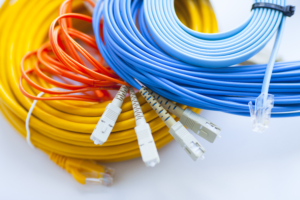Fibre Optic Installation
The first step in a fibre optic installation is to determine the best route for the cable. The installer will take into account factors such as existing infrastructure, topography, and potential obstacles. Once the route is determined, the fibre optic installers will begin to lay the cable.
The next step is to connect the fibre optic cable to a termination box. The termination box contains a device called a transceiver that converts the light pulses into electrical signals. From there, the signals can be sent to a computer or other devices.
Fibre optic installation is a complex and delicate process. It is important to hire experienced professionals to ensure that the job is done correctly. Fibre optic installers have the training, tools, and equipment necessary to complete the installation quickly and efficiently. Contact our fibre optic team today to get started on your project.
Fibre optic cables are the latest in high-speed data transmission technology. Fibre optics use light pulses to transmit information at speeds far greater than traditional copper cables. Fibre optic cables are also much thinner and more flexible than copper, making them ideal for a variety of applications.
Fibre Optic Installers (Single-Mode)
- Single-mode fibre is made from a material called silica, which is a type of glass.
- The diameter of a single-mode fibre is much smaller than the diameter of a human hair.
- The small diameter of single-mode fibre makes it difficult to work with and install.
Single-mode fibre is a type of optical fibre that can carry only one ray of light at a time. This ray of light travels down the length of the fibre in a single line, rather than bouncing around inside the fibre like rays of light do in other types of optical fibre.
Single-mode fibre is used in long-distance communications systems because it can carry signals over longer distances than other types of optical fibre. Furthermore, It’s also used in high-speed data transmission systems because it can carry signals faster than other types fibre.
Fibre Optic Installers (Multi-Mode)
- Multi-mode fibre is made from a material called silica, which is a type of glass.
- The diameter of a multi-mode fibre is much larger than the diameter of a single-mode fibre.
- This makes multi-mode fibre easier to work with and install.
Multi-mode fibre is a type of optical fibre that can carry more than one ray of light at a time. This allows multi-mode fibre to carry signals over shorter distances than single-mode fibre.
Multi-mode fibre is used in short-distance communications systems, such as Fibre Channel and Ethernet. Additionally, It is also used in some data transmission systems. For instance, Fibre Optic Interconnect (FOI).
What is fibre optic used for?
Fibre optic is used for a variety of purposes, including transmitting data and providing internet access.
- Fibre optics can be used for many different types of data transmission, including Internet, telephone, and cable TV.
- Used in medical imaging and telecommunications.
- Medical imaging, such as, endoscopes and CAT scan.
- Industrial applications where light needs to be transmitted through difficult-to-reach places.
Fibre optic cables are also much thinner and lighter than copper cables, making them easier to install and less likely to be damaged. Fibre optics is a rapidly growing technology that is revolutionizing the way data is transmitted. Contact our sales team now for advice, site surveyor a free quote.





